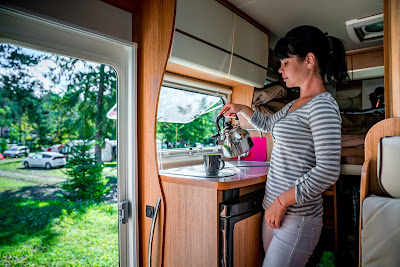Maintaining a Pest-Free RV
Maintaining a Pest-Free RV
Sealing All Openings
The most important thing you can do is make it difficult for
rodents to get into your RV in the first place. The space needed for a mouse to
get into any RV is surprisingly small, so consider any opening a potential
entrance. You’ll need to check your RV from top to bottom, underneath and on
top and seal up even the smallest cracks. Here’s a checklist of places to focus
on:
Undercarriage
Crawl under your RV or camper and check every inch. Take a
flashlight so you can see clearly and look for any spaces that a critter could
crawl through. Check for gaps around the water lines, the sewer lines,
electrical lines, etc. Either caulk the areas or use an expanding foam to seal
them. Be careful the first time you use an expanding foam – using too much can
pinch a line, so go slowly and wait for the foam to fully expand.
Slide-Outs
Look around the edges of your slide-outs and inspect the
rubber gaskets or seals to make sure they haven’t deteriorated or come out of
their tracks. Replace any damaged gaskets and make sure the seal is air-tight when
the slides are closed. If they aren’t seated properly or are misaligned, have
them repaired by a professional.
Doors and Windows
Just like the slide-outs, you’ll want the gaskets and seals
around your door sand windows to be in good shape and seated properly in their
tracks. Replace any seals that are dried-out or damaged. Once you’re on the
road, keep in mind that any time you leave a door or window open, there is the
potential for a rodent to get in, so make sure you have strong, intact screens
in place and never leave doors or windows open when you aren’t in the RV.
Fans and AC Units
Plastic housings for fans and air conditioning systems
aren’t terribly durable. Even the smallest crack can invite insects, snakes or
small rodents. Cracked housings need to be replaced immediately.
Creating an Inhospitable Environment for Pests
While you want your RV to be inviting to human guests, you
don’t want it to be an open invitation to rodents or insects. The right
precautions inside your RV will ensure you aren’t inadvertently advertising
your vehicle as an inviting haven for critters.
Don’t leave wet clothes lying around or let moisture
accumulate in the bathroom or kitchen. This can attract silverfish. It can also
encourage the growth of mildew, which is an attraction for some bugs.
Make sure you store all your food in airtight, sealed
containers. Even dry cereal and spaghetti should be stored in rubber storage
containers with lids or glass jars with sealed lids or screw-on tops. Cardboard
boxes are easy for mice and bugs to chew through. Cardboard also lets the
enticing aroma of food to waft through your RV, attracting the notice of pests
who have a keen sense of smell. Airtight zip-lock bags are also a good option.
Fresh fruit and vegetables need to be eaten or tossed before they become overly
ripe. Fruit flies multiply at an incredible rate and are hard to get rid of
once they’ve settled in.
Food Attracts More Than People
It’s a good idea to limit eating to specific areas of your
RV. While it’s tempting to have a late night snack in bed, it’s easy for crumbs
to go unnoticed and end up under the bed, where they’ll be inviting to pests.
Whenever you do eat, make sure you’ve cleaned up the area every time, including
sweeping up crumbs and wiping down surfaces. If you spill something on a
bedspread or upholstery, wash it as soon as possible so that the stain doesn’t
attract pests.
Garbage that isn’t properly sealed and stored can attract
anything from raccoons to insects. While you may sometimes have to bag your
garbage and carry it out of an area where you’re boondocking, you can take
steps to minimize the problem. Seal the bags tightly and double-bag whenever
possible. If you have to carry it out of the area, make sure you put it
somewhere (such as an outside storage area) that can be easily and thoroughly
cleaned as soon as you dispose of the garbage.
Safe Mice Deterrents
While there are products on the market to keep mice away,
many of them are toxic to people and animals. We don’t recommend using rodent
poisons or mothballs in your RV. They can create a horrible odor and can cause
serious injury or death to children and pets. The EPA has approved a product
called Fresh Cab for indoor use to repel mice. These are pouches filled with
safe, effective herbs that have a scent that mice hate. Tossing a few of these
around pipes, in storage areas, under your sinks and other possible entry areas
can be very effective. You’ll need to replace them every 30-60 days or whenever
they get wet. Peppermint oil can also be effective and has the added benefit of
smelling good. You’ll need to refresh the peppermint oil whenever you can no
longer detect the scent, which will probably be about once a week. It takes
just a few drops in each area to be effective but be careful not to put it on
finishes that could be damaged such as laminates. Instead, soak a cotton ball
in the peppermint oil and tuck into out-of-site corners or inside cabinets.
Keeping Insects at Bay
Bugs can crawl through even the tiniest tears in screens and
cracks around doors, so periodically spraying around these areas with an insect
repellent is a good idea. Some people swear by tucking dryer sheets into food
cupboards and drawers but be aware that these can be irritating to some people.
A more natural solution for ants is to sprinkle talcum powder, baby powder or
chalk around your tires, leveling jacks
and doorways.
Diatomaceous Earth is another way to control insects that is
safe for pets and children. You can find it (be sure to buy the food grade
diatomaceous earth, not the kind used to filter swimming pools) online and in
most garden or feed stores. Simply scatter it around entrances, tires and
leveling gear. It will kill roaches and ants that consume it without using
harmful pesticides.
Bees and stinging insects can be a particular problem
because in some states the only approved way to kill them is with soapy water.
Keep a spray bottle filled with very soapy water (use laundry detergent or dish
soap) on hand and spray the insect to kill it. If you find a nest or hive in or
on your RV, drowning it with soapy water will kill all its occupants, after
which you can safely remove it.
A Brief Word About Snakes
If you’re camping in an area where snakes are present, it’s
easiest to avoid making your RV inviting by parking away from woodpiles, grassy
meadows or areas with lots of brush. Snakes prefer to stay hidden, so any areas
that can easily hide them will attract them and they may end up under or in
your RV. Never leave windows or doors open if you’re in an area where snakes
are common.
Keep It Clean!
The best and simplest way to prevent pests from invading
your RV is to keep it well maintained, sealed and spotless. Always wipe up
spills immediately, don’t leave snacks sitting around for hours, seal food as
soon as you’re done using it, wash dishes immediately and wipe down everything
periodically with a blend of bleach and water (1 part bleach to 10 parts
water). Keep it in a squirt bottle to use on tables and countertops regularly.
Also keep clutter to a minimum. Mice and other rodents love
a cozy nesting spot, so if you have lots of dirty clothes laying around or
craft materials such as paper, string and cardboard shoved into drawers, they
may snatch some nesting materials. Keep these items sealed in storage
containers and pick up clutter to minimize nesting and hiding spaces.
Winter Storage Tips to Keep Pests Out of Your RV
Storing your RV or camper during the winter months or when
not in use creates a special problem when it comes to keeping pests away. An
empty RV is an inviting, safe environment for rodents and insects. It protects
them from predators and provides protection from the elements. If you can store
your RV indoors in a protected area, great! If not, take a few precautions for
minimizing the risk of an infestation:
- Clear all food out of your RV. Don’t leave anything inside, not even food items that are stored properly. Sometimes a container comes open and rodents can chew through plastic given enough time
- Park your RV on a hard surface and away from wooded or grassy areas.
- Thoroughly clean the interior, washing down all hard surfaces with a bleach/water solution
- Vacuum and sweep the floors
- If you have access to your RV when not in use, periodically start the engine to scare mice out of the engine compartment
- Do periodical walk-throughs, looking for mouse droppings in cabinets, under seats, etc. so that you can correct the problem before it gets out of hand
- Toss plenty of Fresh Cab pouches into the cabinets and around openings. Replace them regularly
If you do discover mice or other pests in your RV, don’t
panic! In our next post, we’ll explain how to get rid of pests that are already
in residence and properly clean and disinfect your RV after an infestation.



Comments
Post a Comment